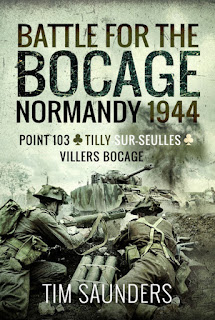Battle for the Bocage, Normandy 1944 - Point 103, Tilly-sur-Seulles and
Villers Bocage written by Tim Saunders and published by Pen & Sword
Books - £25 - Hardback - Pages 376
This is the story of the fighting in Normandy by the veteran desert formations brought
back by Montgomery from the Mediterranean in order to spearhead the invasion;
50th Infantry and 7th Armoured divisions, plus 4th Armoured Brigade. Heavily
reinforced by individuals and fresh units, their task beyond the beaches was to push
south to Villers Bocage with armour on the evening of D-Day in order to disrupt
German counter-attacks on the beachhead.
Difficulties on 50th Division’s beaches and lost opportunities allowed time for the 12th Hitlerjugend SS Panzer Division and the equally elite 130th Panzer Lehr Division to arrive in Normandy, despite delays of their own caused by allied fighter bombers. The result was 4th Armoured Brigade’s thrust south encountered opposition from the start and was firmly blocked just south of Point 103 after an advance of less than 5 miles.
A major counter-attack by Panzer Lehr failed, as did a renewed British attempt, this time by the vaunted 7th Armoured Division, which was halted at Tilly sur Seulles. From here the fighting became a progressively attritional struggle in the hedgerows of the Bocage country south of Bayeux. More and more units were drawn into the fighting, which steadily extended west. Finally, an opportunity, via the Caumont Gap, to outflank the German defences was taken and 7th Armoured Division reached Villers Bocage. Here the County of London Yeomanry encountered the newly arrived Tigers of Michael Wittmann, with disastrous results. The Desert Rats were forced to withdraw having lost much of their reputation.
There then followed what the battalions of 50th Division describe as their ‘most unpleasant period of the war’, in bitter fighting, at often very close quarters, for the ‘next hedgerow’.
This is an excellent book if you're into detailed, and comprehensive descriptive writing that easily details the fighting battle of almost hand to hand combat. If you enjoy reading about the war around the Normandy area, this will definitely be a book for you. The book mainly centres around Point 103 and the area around Bocage, these hard-fought battles are well written and bring the heat of the battle and fear to the book. The book is also well divided up in its chapters, so your not overwhelmed by the knowledge and combat which some could find a little confusing. Certainly a well written book by the author Tim Saunders. I really enjoyed reading this book and would think it would most certainly appeal to fans of the fighting in the Normandy area of France in WWII.


.jpg)








